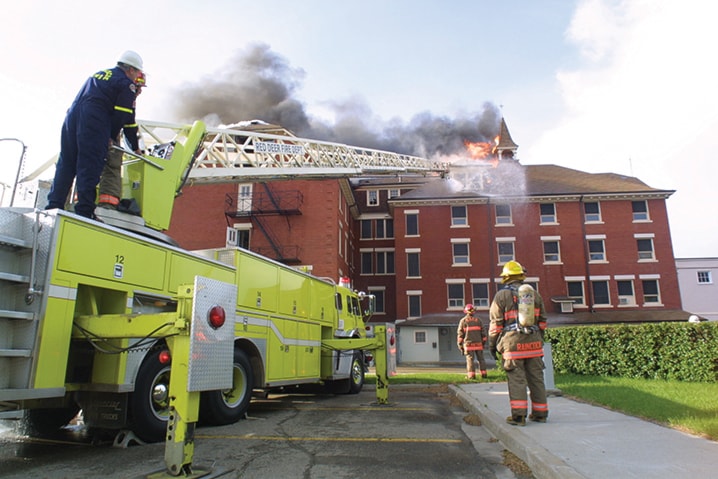The former Michener Centre administration building is one tough old structure.
At about 6 p.m. on June 18, 2003, lightning struck the attic of the four-storey brick building, causing a major fire.
Built in 1913, the building served first as a ladies’ college, next as a sanatorium for shell-shocked veterans from the First World War, and finally in 1923 as the new location for the Home for Mental Defectives, renamed the Provincial Training School for the mentally handicapped. Eventually the building and its sprawling compound became known as Michener Centre.
Steve Gailloux, who served as Michener’s fire chief for 12 years before the volunteer fire department closed its doors in 2008, said firefighters fought the lightning fire for 11 hours.
“It was brutal. That attic space was stuffed with all kinds of things like sawdust. The design of that roof space up there was like a maze. From the hatch access, we couldn’t get to all the spaces. Eventually what we let happen, we let the roof burn through. By creating a hole in the roof, we could gain access from the top and apply water that way,” said Gailloux, 55.
Flames destroyed the roof and most of the upper floor of what was then the South Administration Building of Michener Centre, atop Michener Hill near 40th Avenue.
In November 2008, it reopened as the new administration headquarters for David Thompson Health Region, now known as Alberta Health Services Central Zone.
An east-wing was added to the Provincial Training School building in 1928 and over the years more and more buildings were constructed. A vegetable garden, grain crops, dairy herd, hogs and chickens on the site fed residents and staff.
The Provincial Training School purchased the adjoining Gaetz farm in 1939.
In the 1950s, construction included residences, a new power house, store house, root cellars, fire hall, greenhouse, a house for the superintendent, an eight-room school house, a clinical building, infirmary, sense training building, vocational and occupational therapy building, and a curling rink.
Deerhome, the adult facility built on the north side of the property, opened in 1957, leaving the Provincial Training School for younger residents.
Former Red Deer mayor Morris Flewwelling recalled Michener having tons of flowers in huge, beautifully tended gardens, and the farm produced plenty of vegetables.
Cellars stored food for both residents, and staff, many who lived on the site.
“That’s a lot of food to be stored, The root cellars were major facilities,” Flewwelling, 72, said.
By 1983, Michener was a 66-building complex on 360 acres.
And it all began with the administration building, which was initially home to ladies seeking an education, followed by soldiers suffering nervous conditions.
“Nobody asked if we wanted a home for shell-shocked veterans. The government just said — vacant building, pay the rent, hire the people, do the job, get it done,” Flewwelling said.
Children from a home for ‘mental defectives’ in Edmonton replaced the soldiers, who were moved to an Edmonton facility.
When Gailloux started volunteering for the Michener Fire Department in the 1980s, Michener had about 1,600 residents, plus hundreds of staff.
“Back in the ’80s, it was unbelievable up there. You could have up to 300 (people) in one building,” Gailloux said.
He said the interior layouts could be challenging and require special keys or information for access. Some clients were potentially violent so knowledge of non-violent crisis intervention was required.
But Michener firefighters also had their share of fans.
“We had clients who would come over and volunteer with us. They would help us clean the hall, wash the truck, anything they could do to be around the truck.”
The fire hall also had a supply of industry magazines about firefighting that residents just loved, Gailloux said.
The opening of Roland Michener Recreation Centre in 1977 was a turning point for Michener.
Jim Young, Michener’s longtime director of recreation who retired in 1991, said the construction of the rec centre came about from the government’s advancement of normalization for Michener clients and to help bridge the gap with the rest of Red Deer.
Michener had outgrown its small gymnasium, and Special Olympics, with its opportunity for athletes to travel, was gaining momentum.
Young, 75, said Special Olympics was about recognizing what people can do, not what they couldn’t do, and Red Deer had developed a friendly athletics competition program even before Special Olympics existed.
“I just happened to be watching television one morning when Eunice Kennedy Shriver (sister of U.S. President John F. Kennedy) was talking about the Special Olympic games that were coming up in New York and they said they were being represented from Canada by Ontario. So I phoned her and said that we had a program, and had had a program for several years before Special Olympics — exactly the same thing. So we were invited to take part in the games in New York. It just grew from there,” said Young, who was instrumental in bringing Special Olympics to Western Canada and the Northwest Territories.
During Michener’s millennium celebration in 1999, a time capsule with Michener memories was buried near the recreation centre. The capsule is to be unsealed in 50 years on Aug. 26, 2049.
szielinski@www.reddeeradvocate.com
Coming Tuesday: The workers of Michener Centre have their own special stories.
